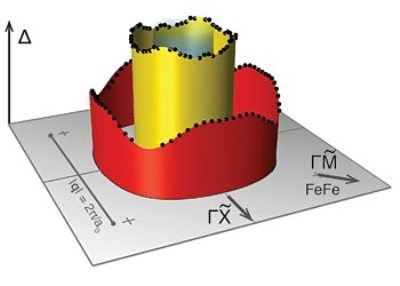A research work conducted by scientists from Brookhaven National Laboratory (BNL) at the U.S. Department of Energy (DOE), St. Andrews University, Cornell University and others has provided direct evidence supporting the theories that the mechanism for superconductivity in materials such as iron-based superconductors is mainly due to magnetism.
 The height of each dot in this image represents the superconducting energy gap — a measure of the strength of electron pairing — for electrons moving at a particular momentum (speed in a given direction) on each electronic band (red and yellow rings) of a particular iron superconductor.
The height of each dot in this image represents the superconducting energy gap — a measure of the strength of electron pairing — for electrons moving at a particular momentum (speed in a given direction) on each electronic band (red and yellow rings) of a particular iron superconductor.
This research may lead to identification or development of new materials with enhanced properties or higher temperature superconductors.
Researchers have been working for years to understand the mechanism behind thehigh-temperature superconductivity. A major step in the superconductivity is the creation of electron pairs. Researchers have assumed that when the magnetic moments of these negatively charged particles point in opposite directions, they can overcome their mutual repulsion and join to form Cooper pairs. Thus, the electron pairs can carry current without any loss.
Several scientists assumed that material shaving alternating magnetic moments on neighboring electrons, known as antiferromagnetic materials, can be converted into superconductors. However, this was not proven. In 2008, the discovery of iron-based superconductors recovered the idea that magnetism played an essential role in high-temperature superconductivity. Multi-band Bogoliubov quasiparticle scattering interference method has been used by the team to carry out the research work. The team has planned to use the same method to evaluate whether the theory is true for several other iron superconductors.
The research received support from the Center for Emergent Superconductivity; the U.K. Engineering and Physical Sciences Research Council; the U.K. Engineering and Physical Sciences Research Council and others.